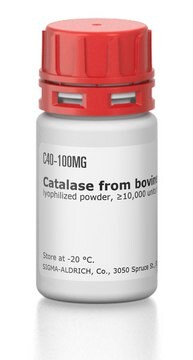MABN1843
Anti-SET (I2PP2A) Antibody, N-term Antibody, clone 10E7
clone 10E7, from mouse
Synonyme(s) :
Protein SET, HLA-DR-associated protein II, IGAAD, Inhibitor of granzyme A-activated DNase, PHAPII, I-2PP2A, Phosphatase 2A inhibitor I2PP2A, TAF-I, Template-activating factor I
About This Item
Produits recommandés
Source biologique
mouse
Niveau de qualité
Forme d'anticorps
purified immunoglobulin
Type de produit anticorps
primary antibodies
Clone
10E7, monoclonal
Espèces réactives
rat, human, monkey
Technique(s)
western blot: suitable
Isotype
IgG2aκ
Numéro d'accès NCBI
Numéro d'accès UniProt
Conditions d'expédition
ambient
Modification post-traductionnelle de la cible
unmodified
Informations sur le gène
human ... SET(6418)
Description générale
Spécificité
Immunogène
Application
Neuroscience
Western Blotting Analysis: A representative lot detected endogenous monkey SET (I2PP2A) as well as full-length human SET constructs (Wild-type, R179A/K180A/R181A, K168A/R169A) exogenously expressed in COS-7 cells (Arif, M., et al. (2014). J. Biol. Chem. 289(40):27677-27691).
Western Blotting Analysis: A representative lot detected full-length Myc-tagged human SET (I2PP2A) and its N-terminal cleavage product (NCP) in transfected COS-7 cells. Only NCP and Asn endopeptidase-/AEP-cleaved N-terminal fragment I2NTF, but not the full-length SET, were detected in COS-7 co-transfected with full-length SET and AEP, while acidic pH treatment of the COS-7 transfectants resulted in the detection of only I2NTF, but not NCP (Basurto-Islas, G., et al. (2013). J. Biol. Chem. 288(24):17495-17507).
Western Blotting Analysis: A representative lot detected both endogenous SET (I2PP2A) in untransfected PC12 cells and exogenously overexpressed SET (I2PP2A) in PC12 rat adrenal pheochromocytoma cells.
Qualité
Western Blotting Analysis: 0.5 µg/mL of this antibody detected SET (I2PP2A) isoforms in 10 µg of Jurkat cell lysate.
Description de la cible
Forme physique
Stockage et stabilité
Autres remarques
Clause de non-responsabilité
Vous ne trouvez pas le bon produit ?
Essayez notre Outil de sélection de produits.
Code de la classe de stockage
12 - Non Combustible Liquids
Classe de danger pour l'eau (WGK)
WGK 1
Point d'éclair (°F)
Not applicable
Point d'éclair (°C)
Not applicable
Certificats d'analyse (COA)
Recherchez un Certificats d'analyse (COA) en saisissant le numéro de lot du produit. Les numéros de lot figurent sur l'étiquette du produit après les mots "Lot" ou "Batch".
Déjà en possession de ce produit ?
Retrouvez la documentation relative aux produits que vous avez récemment achetés dans la Bibliothèque de documents.
Notre équipe de scientifiques dispose d'une expérience dans tous les secteurs de la recherche, notamment en sciences de la vie, science des matériaux, synthèse chimique, chromatographie, analyse et dans de nombreux autres domaines..
Contacter notre Service technique







